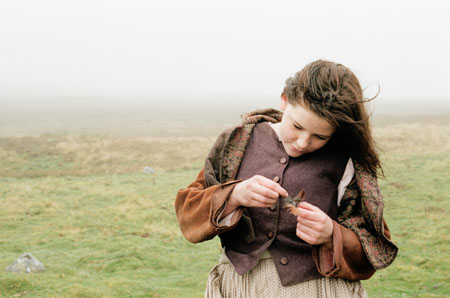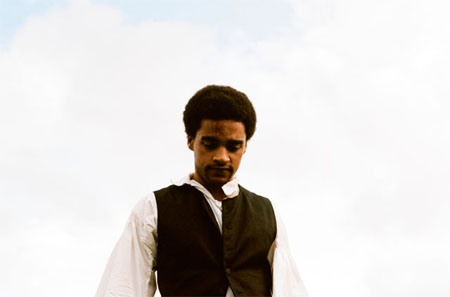We’ll begin with Keith Phipps‘s opener at the AV Club: “A grim chord played in a minor key and sustained for the length of a novel, Emily Brontë’s Wuthering Heights is equal parts compelling and oppressive, a near-relentless depiction of the hell people make for each other when love curdles under the heat of disappointment. Brontë’s novel easily supports distant, Masterpiece Theater-inspired takes and lent itself beautifully to a 1939 William Wyler adaptation starring Laurence Olivier and Merle Oberon, but any stately approach takes the roundabout route to the book’s dark heart. Andrea Arnold’s new adaptation eschews any niceties, opting for handheld camerawork, unfettered emotions, casual brutality, and flashes of piercing beauty. Shot in the Yorkshire moors that gave the book its setting, it’s an intense, uncompromising take that restores some of the shock that made Wuthering Heights so notable when it first appeared.”
Joseph Jon Lanthier in Slant on the setting: “The land’s ferality, its lucid acceptance of life and death and rest and agitation in equal measure, exacts an unbecoming frankness upon civilized interlopers, whatever their wealth or education. Angered gusts scream across the hills; scattered grouse skeletons offer impromptu lessons in natural selection. Both God and the Royal Family seem like distant delusions hardly worth arranging one’s nasty little life around. The book’s moral dilemma concerns, in one respect, an adolescent choice between savagery (intuition) and culture (reason), but the two options are not equally weighted. Inhabitants of the moors need not select elemental chaos; they either capitulate to it or struggle against its ubiquity.” What’s more, the 4:3 aspect ratio “recalls the tall, narrow landscapes of German romantic painters such as Caspar David Friedrich; his marshmallow-y fog banks and pointy-haired wanderers are an obvious visual reference.”
For Michael Atkinson, writing in the Voice, the film’s “coup de grâce has everything to do with race. Brontëans may well be shocked at Arnold’s reshaping the classic-lit tale, via the conception of Heathcliff as a black man, and casting Yorkshire non-pros Solomon Glave (young) and James Howson (adult) as the ‘dark-hearted’ orphan-turned-heartbroken-titan.” Allow us a brief digression here:
Unlike in the theater, the use of race this way has not been common in movies. Most often, the appearance of a black actor/character in a role ordinarily doled out to whites is a device used as a joke (as in 1974’s Blazing Saddles), or as a cudgel against racial bigotry, à la Guess Who’s Coming to Dinner (1967). Of course, you could say virtually any movie about endemic racism, from Sergeant Rutledge (1960) to The Man (1972) to Far From Heaven (2002), uses this dialectic, simply by dramatic virtue of having the white characters wonder how in hell the black characters came to be so deeply in their midst. In this Our Age of Denzel, this idea has pleasingly dissipated, so that Washington taking on Don Pedro in Much Ado About Nothing (1993) signifies absolutely nothing. One must search for historical contexts in which to raise the point at all. In the ’90s, critic David Thomson opined that Morgan Freeman might be the only living American actor with stature enough to play Lincoln, as irony might have it; not long thereafter, Dennis Haysbert was the unremarked-upon modern president in 24 (2001–2006), a tenure that, it seemed, suffered less barely repressed racist hatred across the country than the real-life movie Obama began to unspool two years later.
Back to the film and its style, which New York‘s David Edelstein finds to be “an objective correlative for the lovers’ uncontrollable passion, which means a camera that sways and swerves and sometimes fairly trembles with longing. The theory works. The movie doesn’t.” More from A.O. Scott in the New York Times: “The jump cuts, off-kilter angles and hurtling hand-held camerawork; the guttural stammerings of the actors; and the ambient muck of the production design are signs of what has become a familiar aesthetic agenda. These techniques are meant to create a sense of immediacy, a supremely powerful naturalism. But in this case, curiously enough, the effect is the opposite. The grunts and howls seem every bit as mannered as the florid diction of Olivier and Oberon, perhaps even more so. Their artifice, like Brontë’s own, was overt, whereas Ms. Arnold strives to disguise hers in the trappings of authenticity. And as a result, the impact—the grandeur, the art—of Wuthering Heights is diminished.”
“If you could feel Arnold pushing against the boundaries of cinematic form in Fish Tank and Red Road—both magnificently photographed by Robbie Ryan—those were nonetheless conventionally plotted films with reasonably tight structures,” writes Salon‘s Andrew O’Hehir. Wuthering Heights “suggests a leaner, meaner, British-centric Terrence Malick. Arnold captures the almost wordless, half-animalistic childhood existence of Heathcliff and Cathy as they wander the bleak and wondrous landscape, clutch each other on horseback, play erotic games amid the mud and rocks or comfort each other after Heathcliff—treated as little more than a servant—absorbs another vicious beating. There’s very little dialogue in the first half of the movie (the screenplay is by Arnold and Olivia Hetreed), and what there is feels like an almost irrelevant intrusion.”
Let’s take a moment, then, for a brief plot outline, courtesy of David Belcher in the NYT: “Heathcliff and Cathy, raised as adopted siblings, fall in love but are torn apart by their agonized passion and a jealous brother, Hindley. They find solace on the desolate moors, but Cathy’s marriage to a wealthy neighbor, Edgar, turns Heathcliff bitter, and he disappears for years, returning a rich man but reconnecting too late, as Cathy dies after giving birth to a daughter. But that’s not the end, and even the most moor-obsessed among us would be hard-pressed to recall the second half of the book, when Cathy’s daughter grows up to marry both Heathcliff’s son and, after his premature death, Hindley’s son, while an aged Heathcliff tries to manipulate their fates.”
“Arnold keeps some gas in the tank for a full-throttle closer but it’s an unavoidable observation that her Wuthering Heights, no less than Brontë’s, is a work that falls off drastically in its second act,” finds J. Hoberman, writing for Artinfo. “Still, the characters are prone to an unlikely but programmatic lack of propriety and Arnold is able to maintain the novel’s essential violence and cruelty. A great admirer of Wuthering Heights, Camille Paglia described it as ‘a catalog of chthonian horrors,’ while characterizing the ill-fated lovers, Catherine and Heathcliff, as ‘self-maiming priests of a pagan cult of unmaternal stormy nature.’ The French surrealists admired Wuthering Heights for its unflinching evocation of l’amour fou, along with a cruelty that reminded them of the ‘divine’ Marquis de Sade. This too is a movie with a bite.”
More from Nicholas Bell (Ioncinema, 4/5), Tim Grierson (IFC), Tynan Kogane (Cinespect), Elina Mishuris (L), Mary Pols (Time) Joshua Rothkopf (Time Out New York, 4/5), Shelagh M. Rowan-Legg (Twitch), and Dana Stevens (Slate). Interviews with Arnold: Ed Champion, Dustin Chang (Twitch), Austin Dale (indieWIRE), David Fear (TONY), Brandon Harris (Filmmaker), Aaron Hillis (Voice), and Sophia Savage (Thompson on Hollywood).
Wuthering Heights opens at Film Forum in New York today before roaming the country through mid-December.
Update, 10/7: “The film’s two parts reflect if not different sensibilities, then strongly different relationships to the source material,” writes Genevieve Yue in Reverse Shot. “While the second is cluttered with events from the novel, much of it involving thrashing (not to mention grave-digging, head-slamming, and an implied act of necrophilia), it moves considerably slower than the first, owing, in part, to the adult actors’ wan and whinging performances. [Kaya] Scodelario is slight by comparison to Beers’s sturdy, hale Cathy, and while the emotional toll of her years of separation from Heathcliff might explain her frailty, the intensity of her eyes are also diminished, despite Scodelario’s mannered attempts to flash them at Heathcliff. In figure, meanwhile, [James] Howson cuts the fitting image of the changed, now gentlemanly Heathcliff, though in speaking he loses much of the character’s fierce reserve. The wild otherness of the young Heathcliff derives largely from Glave’s nearly mute performance; when words form in his mouth they are not so much said as spat. Howson’s torrents of speech, though they reveal more of the hero’s anguish, have the adverse effect of making him less Byronic than melodramatic…. As in her previous film, Fish Tank, Arnold is far more attentive to the nervy tempos of teenage life, caught in fleeting glimpses, than the lifeless and disappointing adults against whom her characters rebel.”
Update, 10/26: “[I]t’s Twilight!” exclaims Francine Prose in an entry at the NYRBlog. “Transplanted from the rainy Pacific Northwest to even rainier rural England, deftly substituting a ghost for a vampire, the film contains many of the elements that made the screen version of Stephenie Meyer’s novel such a hit: repressed adolescent passion, self-denial, questions of masculinity, sexual competition, renunciation, romance thwarted by restrictive tribal loyalties. That’s how I would have pitched the film, and the fact that I was thinking of it while watching Heathcliff and Catherine break each other’s hearts was an indication of Arnold’s failure to capture a fraction of Brontë’s genius.”
For news and tips throughout the day every day, follow @KeyframeDaily on Twitter and/or the RSS feed. Get Keyframe Daily in your inbox by signing in at fandor.com/daily.






